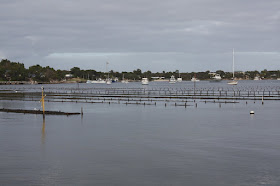
When we signed up at the Information Centre in Ceduna to play the Nullarbor Links, we paid $50.00 each and received our score cards and a piece of wetsuit fabric about 12” x 12” with a small hole in the middle....wondering why we would need such a thing.
After seeing the first hole we knew why. There is no grass at all. The tee off area is a small platform covered in astroturf, as is the green. All the holes have the same tee off platform, different shaped greens but between is vastly different. Once you are on the fairway you place your green piece of wetsuit fabric on the ground, put your tee in the hole, ball on top, select your club, hit the ball and keep your fingers crossed that you will be able to find it.
Some of the fairways are all salt bush, some are trees and bushes, some are cleared red dirt fairway with a few tufts of something growing here and there. One has a sign warning of snakes and we saw a Red Belly Black,
 another has “tree traps” instead of sand traps- they have bulldozed a few
another has “tree traps” instead of sand traps- they have bulldozed a few trees and piled them together at a couple of places on the course. The funniest one was a large bulls-eye that we could see between the trees, which was showing us where the flag and green were.
trees and piled them together at a couple of places on the course. The funniest one was a large bulls-eye that we could see between the trees, which was showing us where the flag and green were.The flies were so bad when we played at Norseman that I had to bring out the “fly veil.” It looks ridiculous but saves the flies from driving you crazy.
Your card is stamped at each hole which is usually beside a roadhouse and then you are presented with a certificate at the Information Centre at Kalgoorlie.
We have really enjoyed the last three days. It was a great laugh and gave us something to look forward to every 100 klms or so and made the trip go quickly. The total journey was 1641 klms. It truly is the longest golf course in the world.




































